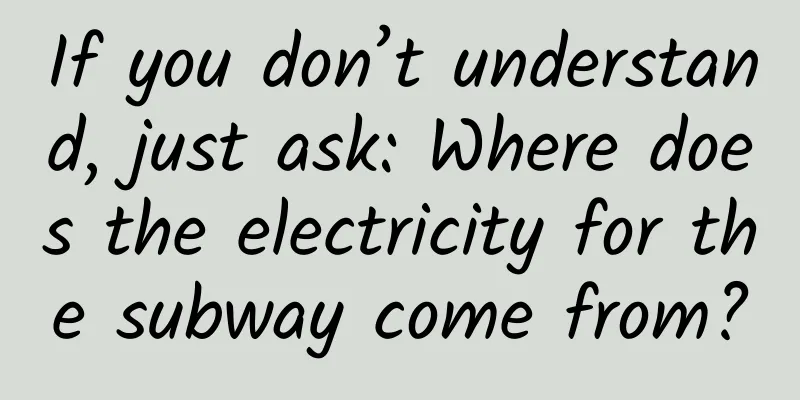If you don’t understand, just ask: Where does the electricity for the subway come from?

|
In our city, subway lines that run day and night form a crisscrossing underground transportation network. Every day, the bustling crowds of people meet here and then flow to every corner of the city. Beijing Subway Map (April 2024 Edition) The subway is the main artery of modern urban transportation, and its safe and stable operation is of vital importance. As more and more black technologies such as face recognition for instant gate passing, smart screen interaction, and robot inspections are introduced into subway stations, a stable and reliable power supply system is essential. In April 2021, an intelligent inspection robot carried out inspection work in the substation of Majiabao Depot on Beijing-Hong Kong Metro Line 4. Today we are going to talk about subway power supply~~~ Let me ask you first, do you know where the electricity used in the subway comes from? And how is it delivered to the subway? Just like our household electricity, the subway itself also needs to purchase electricity from the power grid company, except that the household electricity is 220V AC low-voltage electricity. If the subway is such a huge thing, it is tantamount to "a small horse pulling a big cart" if it only uses the conventional 220V voltage. Therefore, the subway usually uses 110kV high-voltage power from the power grid company, and then converts the high-voltage electricity into 750V or 1500V DC through the traction substation and step-down substation in the system to power hundreds of electrical equipment such as the trains people take and the escalators they use. It is worth noting that the electricity bill expenditure of the subway accounts for about 10% of the total cost of the subway, including labor, consumables, etc. The first "driverless" subway in China - traction substation of Beijing Metro Yanfang Line Now that we know where the electricity comes from, how is it delivered to the subway? Currently, there are two main ways to power subway trains: third rail power supply and overhead contact network power supply. The third rail is called this name to distinguish it from the two parallel rails used for subway trains. It is a contact rail installed next to the subway line and used solely for power supply. The train contacts and slides on the surface of the charged contact rail through its own collector, and transmits electricity to the train. This collector is called a "collector shoe." In simple terms, the "collector shoe" device of the train is placed on the third rail to draw electricity from the ground. Therefore, the rails in the tunnel are not charged, and only the third rail is charged. Since it is right next to the rails, in order to prevent people from accidentally getting electric shock, the third rail is generally wrapped in an insulating protective cover. Schematic diagram of third rail power supply Next, let's talk about catenary power supply, which is to draw electricity from the air. This is very similar to high-speed rail: a catenary is set up above the tunnel, and the vehicle draws current from the contact wire through the pantograph. Generally speaking, catenary power supply is safer, after all, the electricity is transmitted in the cables above the train, and electric shock accidents are less likely to occur. However, the existence of the catenary will affect the beauty of the city, and it requires the erection of many cables, which is difficult and expensive to lay. In May 2020, construction workers used a ladder car to adjust the contact network ground wire on the line 18 of Shanghai Metro from Xiayan Station to Shenmei Station. How to distinguish these two power supply methods? It is very simple. If you see a "braid" extending upwards on the top of the subway like a tram, or there is a cable power supply above the rail, then it must be the overhead power supply. If there are none of the above characteristics, it can be basically determined that it is the third rail power supply. In 2023, the Beijing Subway Line 6 train pantograph autonomous maintenance base will be completed and put into use, which can realize the whole process of train pantograph disassembly, maintenance, inspection, installation, etc. Some of you must have imagined this scenario when riding the subway: What if the subway suddenly loses power? In fact, there are generally two types of subway power outages: power outages occur on the platform, or when the train is running in the tunnel. Imagine that once the power is instantly interrupted, the subway's signal lights, train dispatching, station gates and other devices will fail, and a large number of passengers will be trapped in a dark underground tunnel, which is not only likely to cause operational accidents, but also easily cause widespread panic and lead to stampedes. In the early morning of March 18, 2019, the Hong Kong MTR experienced the most serious train collision since its opening. Two empty trains collided during the testing of the new signal system. Don't panic, is the subway running every day safe? As an important electricity-consuming department, the power supply of the subway is different from that of general industrial and civilian power supply. At present, domestic subways generally use two independent power supplies on both sides. That is to say, when any power supply fails, the other power supply can also ensure the normal power supply of the subway. The dual power supply guarantee makes the subway's power supply safe and reliable. Therefore, the probability of power outages in domestic subways can be said to be very small. Schematic diagram of independent power supply bilateral power supply used in domestic subways In addition, the power supply company will regularly perform maintenance and inspection on the power supply system and equipment to ensure the safety of subway power supply. In August 2021, staff from the Beijing Metro Power Supply Department were conducting cable connection work at night. May Day holiday There are many subway power supply people Choose to stick to your post Escort passengers on holiday travel safety Let us pay tribute to them References [1] Chen Yaorong, Li Yiling, Yu Qiubo et al. (eds.). Industrial Technology for Maintenance and Fault Handling of Subway Power Supply System and Electrical Facilities[M]. 1. China Machinery Industry Press, 2018. [2] Zhou Gaobo. Research on reliability and safety analysis methods of subway power supply system[J]. City Weekly, 2019(39):1. [3] Li Xiao. A brief introduction to subway power supply system and its common problems and solutions [J]. Communications World, 2017(23):1. DOI:CNKI:SUN:TXSJ.0.2017-23-203. [4] Duan Mingyuan. Discussion on safety risk control of subway power supply system construction[J]. 2021.DOI:10.12253/j.issn.2096-3661.2021.03.2732. Yingda Media Investment Group Co., Ltd. Wu Di |
>>: Is there really no way to deal with antibiotic resistance? Future antidotes to "superbugs" →
Recommend
5 Tips for Using Tik Tok to Master Film and Television Marketing!
Since Tik Tok became popular, there is another ne...
Buying a membership on iOS is 100 yuan more expensive than on Android. Is this price discrimination due to the "Apple tax"?
After decades of user education, it is not diffic...
How to enable the appearance permission for Taobao Live? What are the requirements for activating the right to appear on Taobao Live?
This article mainly introduces how to activate th...
How did Zhihu/Mafengwo/Boss Zhipin promote themselves during the World Cup?
Today, we will share from a practical operation p...
Russia's flying electric car starts accepting pre-orders, priced from 500,000 rubles
On June 26, according to Russian media reports, th...
Google AI: No one knows how it works
【51CTO.com Quick Translation】Google Brain has cre...
Dafeng Mini Program Development Company, how much does it cost to develop a printing mini program?
According to industry insiders, mini programs wil...
In order to make iPhone X better for web browsing, I added a navigation button to the web page
Editor's note: After the release of iPhoneX, ...
Children's favorite "Hex" beverages can easily lead to precocious puberty? Pay attention to these points when choosing children's food
Recently, the topic of "Hex drinks increase ...
Reading is like overcoming a tribulation. Perhaps it is this "disease" that is causing the problem.
Review expert: Yin Tielun, deputy chief physician...
Website SEO diagnosis and optimization plan case: The website went from “0” to “2” in one month!
Case Description: I made this website myself. Aft...
What is the difference between cooling at 26℃ and heating at 26℃? Why do pineapples need to be immersed in salt water? Come and learn more
Turn on the air conditioner in winter Set to &quo...
A guide to creative optimization of information flow in four popular industries: e-commerce, automobiles, games, and tourism
Information flow advertising has now become an es...
How do fish avoid danger? What are some ways to defend against enemies?
Produced by: Science Popularization China Author:...
Tips for building the underlying framework for event operations!
Regarding event operation , many operators are fa...









